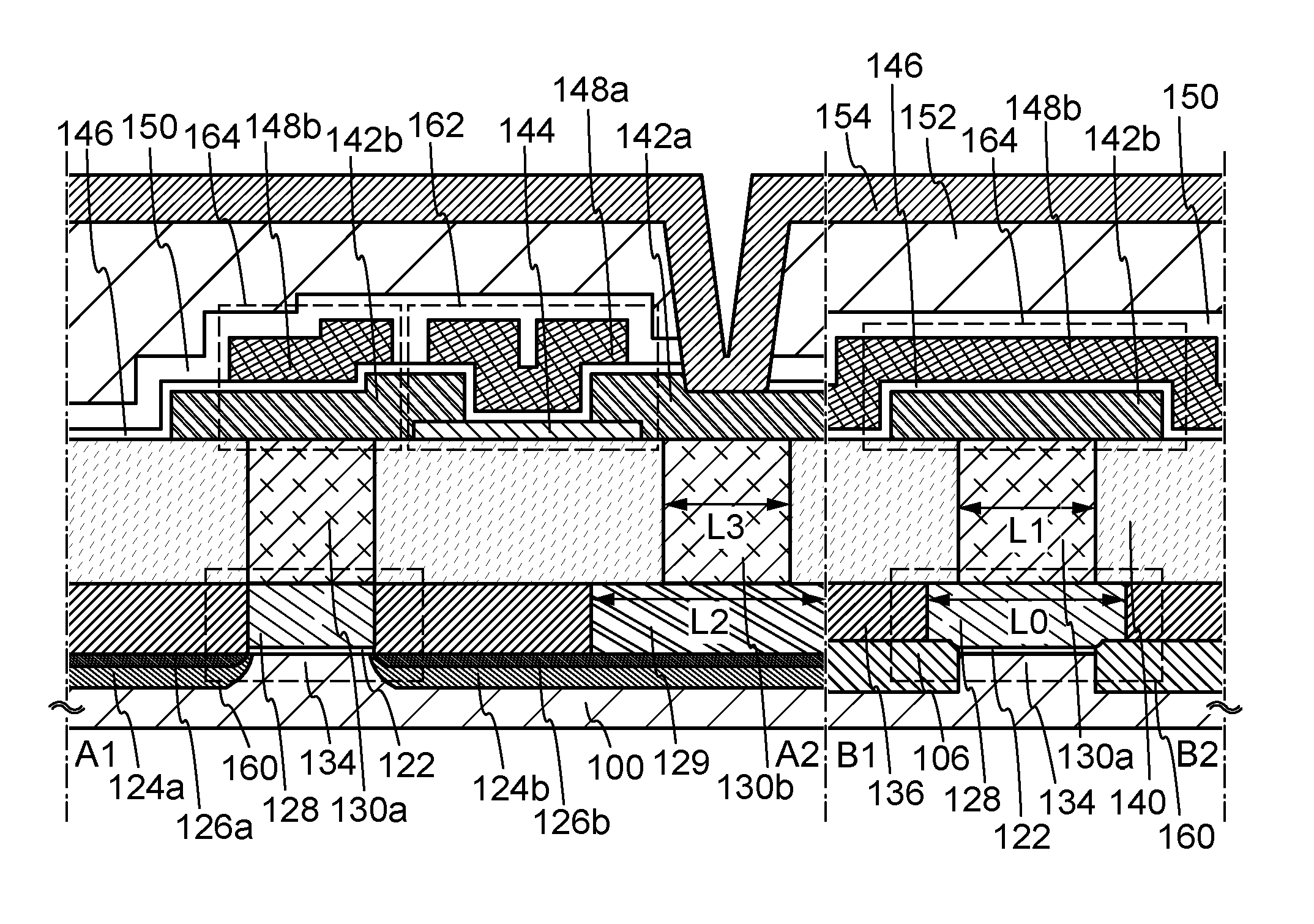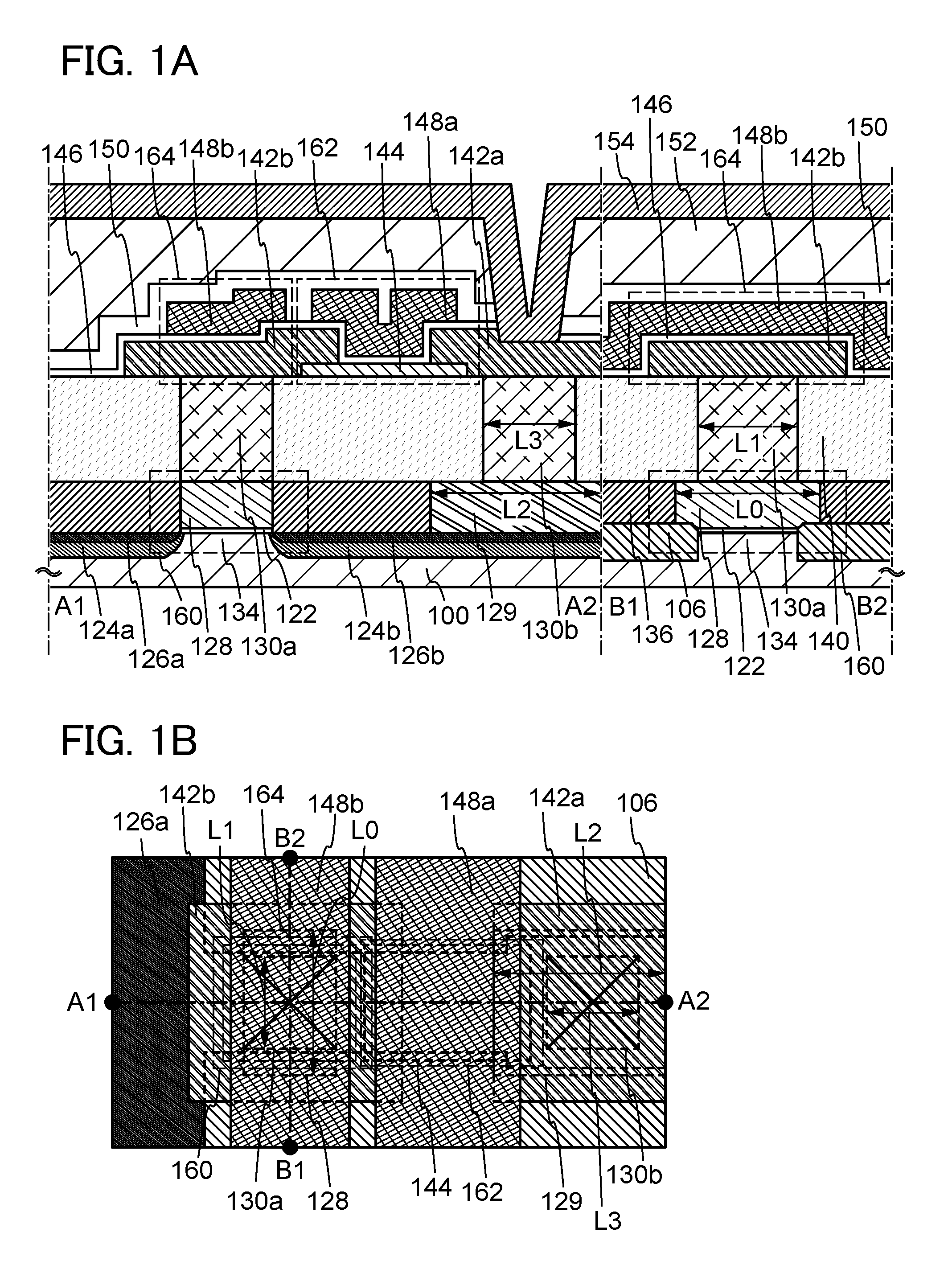Semiconductor device
a technology of semiconductor devices and semiconductors, applied in semiconductor devices, solid-state devices, instruments, etc., can solve the problems of short data retention period, difficult to sufficiently reduce power consumption, and loss of stored data, so as to reduce power consumption and reduce power consumption. the effect of short channel effect, short channel effect, and increased storage capacity per unit area
- Summary
- Abstract
- Description
- Claims
- Application Information
AI Technical Summary
Benefits of technology
Problems solved by technology
Method used
Image
Examples
embodiment 1
[0051]In this embodiment, the structure of a semiconductor device according to one embodiment of the present invention is described with reference to FIGS. 1A and 1B and FIGS. 2A to 2D.
[0052]FIGS. 1A and 1B illustrate a structure example of a semiconductor device. FIG. 1A is a cross-sectional view of the semiconductor device, and FIG. 1B is a plan view of the semiconductor device. Line A1-A2 in FIG. 1A corresponds to line A1-A2 in FIG. 1B, and a cross-sectional view taken along line A1-A2 in FIG. 1A illustrates the semiconductor device in a direction parallel to a channel length direction of a transistor. Further, line B1-B2 in FIG. 1A corresponds to line B1-B2 in FIG. 1B, and a cross-sectional view taken along line B1-B2 in FIG. 1A illustrates the semiconductor device in a direction perpendicular to the channel length direction of the transistor. The semiconductor device in FIGS. 1A and 1B includes a transistor 160 including a first semiconductor material in a lower portion and a t...
embodiment 2
[0116]In this embodiment, a method for forming the semiconductor device described in the above embodiment with reference to FIGS. 1A and 1B is described with reference to FIGS. 3A to 3D, FIGS. 4A to 4C, FIGS. 5A to 5D, FIGS. 6A to 6C, FIGS. 7A and 7B, and FIGS. 8A and 8B.
[0117]A method for forming the transistor 160 in a lower portion is described with reference to FIGS. 3A to 3D, FIGS. 4A to 4C, and FIGS. 5A to 5D.
[0118]First, the semiconductor substrate 100 is prepared (see FIG. 3A). A single crystal semiconductor substrate or a polycrystalline semiconductor substrate of silicon, silicon carbide, or the like; a compound semiconductor substrate of silicon germanium or the like; an SOI substrate; or the like can be used as the semiconductor substrate 100. Here, an example in which a single crystal silicon substrate is used as the semiconductor substrate 100 is described. Note that although the term “SOI substrate” generally means a substrate where a silicon semiconductor layer is pr...
embodiment 3
[0213]In this embodiment, a structure of a semiconductor device according to one embodiment of the present invention that is different from the structure of the semiconductor device in the above embodiment is described with reference to FIGS. 9A and 9B.
[0214]FIGS. 9A and 9B illustrate a structure example of a semiconductor device. FIG. 9A is a cross-sectional view of the semiconductor device, and FIG. 9B is a plan view of the semiconductor device. Line A1-A2 in FIG. 9A corresponds to line A1-A2 in FIG. 9B, and a cross-sectional view taken along line A1-A2 in FIG. 9A illustrates the semiconductor device in a direction parallel to the channel length direction of a transistor. Further, line B1-B2 in FIG. 9A corresponds to line B1-B2 in FIG. 9B, and a cross-sectional view taken along line B1-B2 in FIG. 9A illustrates the semiconductor device in a direction perpendicular to the channel length direction of the transistor.
[0215]A transistor 260 includes a channel formation region 234 provi...
PUM
 Login to View More
Login to View More Abstract
Description
Claims
Application Information
 Login to View More
Login to View More - R&D
- Intellectual Property
- Life Sciences
- Materials
- Tech Scout
- Unparalleled Data Quality
- Higher Quality Content
- 60% Fewer Hallucinations
Browse by: Latest US Patents, China's latest patents, Technical Efficacy Thesaurus, Application Domain, Technology Topic, Popular Technical Reports.
© 2025 PatSnap. All rights reserved.Legal|Privacy policy|Modern Slavery Act Transparency Statement|Sitemap|About US| Contact US: help@patsnap.com



